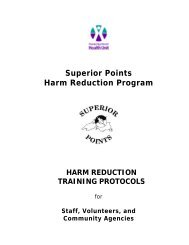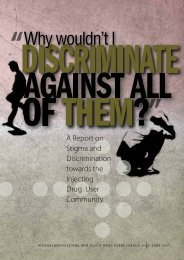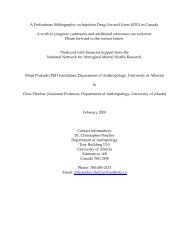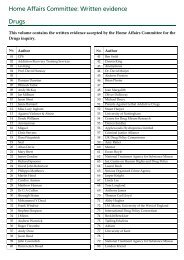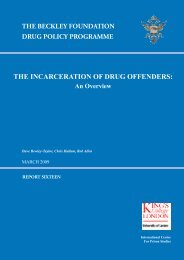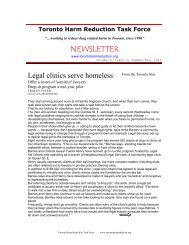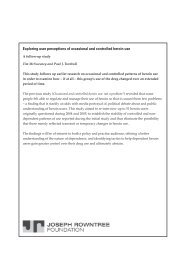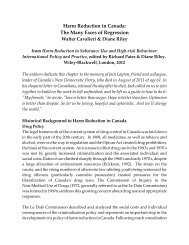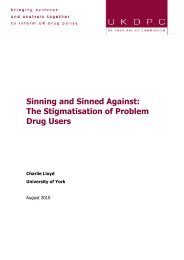and the building of the harm reduction-abstinence ... - ResearchGate
and the building of the harm reduction-abstinence ... - ResearchGate
and the building of the harm reduction-abstinence ... - ResearchGate
You also want an ePaper? Increase the reach of your titles
YUMPU automatically turns print PDFs into web optimized ePapers that Google loves.
242<br />
S.H. Kellogg / Journal <strong>of</strong> Substance Abuse Treatment 25 (2003) 241–247<br />
Table 1<br />
Diagnosis <strong>and</strong> HR intervention<br />
Extreme Dependence Dependence Abuse Use<br />
Dance Drug/‘‘Ecstasy’’ testing—————————————— X<br />
Substance Use Management—————————————————————————————————————–X<br />
Moderation Interventions——————————————————————————X<br />
Harm Reduction Psycho<strong>the</strong>rapy————————————————— X<br />
Buprenorphine-Naloxone Treatment—————— X<br />
Safety Glassware in Bars——————————————————————————————————————–X<br />
Designated Drivers————————————————————————————————————————— X<br />
Server Training——————————————————————————————————————————– X<br />
Earlier Liquor Store Hours to Prevent<br />
Non-Beverage Alcohol Consumption——X<br />
Needle/Syringe Exchange—————————————X<br />
Safe Use/Injection Rooms—————————————X<br />
Heroin Maintenance——————————————— X<br />
Drop-in Centers—————————————————X<br />
Low Threshold——————X Medium/High Threshold —X<br />
Methadone Treatment<br />
Methadone Treatment<br />
Contingency Management Approaches Based on Use Reduction————————X<br />
Naltrexone (Alcohol)————————————————————————————–X<br />
St<strong>and</strong>ard Methadone Treatment————————————————————— X<br />
Naloxone Distribution—————————————————————————————————————X<br />
Motivational Interviewing————————————————————————————————————————————X<br />
Acupuncture <strong>and</strong> Herbal Treatments——————————————————————————————————————————————— X<br />
Overdose <strong>and</strong> Safe Injection Information————————————————————————————————————————————— X<br />
Drug <strong>and</strong> Alcohol Education—————————————————————————————————————————————————— X<br />
(i.e., safety glassware to protect patrons during fights in bars<br />
or pubs). The time perspective is, generally, somewhat<br />
longer than those in <strong>the</strong> ‘‘staying alive’’ group.<br />
The ‘‘getting better’’ group includes interventions that<br />
look more to control <strong>and</strong> reduce use—if not necessarily<br />
eliminate it. As can be seen from <strong>the</strong> list, most <strong>of</strong> <strong>the</strong>se<br />
interventions have some kind <strong>of</strong> <strong>the</strong>rapist-patient or physician-patient<br />
aspect to <strong>the</strong>m, while <strong>the</strong> o<strong>the</strong>r two groups are<br />
more focused on paraphernalia <strong>and</strong> education.<br />
Some <strong>of</strong> <strong>the</strong> concerns about <strong>harm</strong> <strong>reduction</strong> interventions<br />
can be clarified, if not necessarily resolved, through <strong>the</strong> use<br />
<strong>of</strong> this goal typology. For example, <strong>the</strong>re has been some<br />
distress expressed over <strong>the</strong> <strong>the</strong>rapeutic value <strong>of</strong> low threshold<br />
methadone programs (Ball & Van de Wijngaart, 1994) in<br />
that continued drug use may be a common occurrence<br />
(Reuter, 1994). However, low threshold programs have been<br />
found to reduce HIV infection because <strong>the</strong>y lead to lower<br />
levels <strong>of</strong> heroin abuse—even if <strong>the</strong>y do not result in <strong>the</strong><br />
rehabilitation <strong>of</strong> most <strong>of</strong> <strong>the</strong> patients (Rezza, 1994). In this<br />
respect, <strong>the</strong>y meet <strong>the</strong> first two goals, if not <strong>the</strong> third. Wodak<br />
(1994) argues that this is not necessarily without some<br />
<strong>the</strong>rapeutic potential as many drug- <strong>and</strong> alcohol-dependent<br />
persons do eventually terminate <strong>the</strong>ir use, <strong>and</strong> that ‘‘simply<br />
keeping alcohol- <strong>and</strong> drug-dependent people alive <strong>and</strong> well<br />
for as long as possible is a very important component <strong>of</strong><br />
treatment’’ (p. 804).<br />
The third <strong>harm</strong> <strong>reduction</strong> categorization seeks to look at<br />
<strong>the</strong> relationship between intervention <strong>and</strong> motivational state.<br />
For <strong>the</strong> most part, <strong>harm</strong>-<strong>reduction</strong> approaches <strong>and</strong> <strong>abstinence</strong>-only<br />
approaches are fundamentally addressing <strong>the</strong>mselves<br />
to <strong>the</strong> needs <strong>of</strong> different groups. That is, <strong>the</strong> ideal<br />
target group for reduced-use interventions would be individuals<br />
who: (1) would quality for a DSM-IV diagnosis <strong>of</strong><br />
alcohol or substance abuse or perhaps meet <strong>the</strong> minimum<br />
criteria for a DSM-IV dependence diagnosis; <strong>and</strong> (2) who<br />
are seeking to reduce but not discontinue <strong>the</strong>ir involvement<br />
with drugs <strong>and</strong> alcohol (Klaw & Humphreys, 2000; Larimer<br />
& Marlatt, 1990; Marlatt, Larimer, Baer, & Quigley, 1993).<br />
One <strong>of</strong> <strong>the</strong> positives <strong>of</strong> this option is that by giving <strong>the</strong>se<br />
individuals an opportunity to attempt moderation, a number<br />
<strong>of</strong> <strong>the</strong>m will <strong>the</strong>n chose to cease using drugs or alcohol<br />
(Marlatt, Larimer, et al., 1993; Marlatt, Somers, & Tapert,<br />
1993; Tatarsky, 1998). In terms <strong>of</strong> men <strong>and</strong> women who<br />
would qualify for a diagnosis <strong>of</strong> alcohol or substance<br />
dependence, <strong>abstinence</strong>-oriented programs serve <strong>the</strong> needs<br />
<strong>of</strong> those who wish to stop using, while <strong>harm</strong> <strong>reduction</strong><br />
interventions serve <strong>the</strong> needs <strong>of</strong> those who are not in<br />
treatment, do not presently wish to be, <strong>and</strong> may not be<br />
ready to discontinue <strong>the</strong>ir substance use. Again, some <strong>of</strong> <strong>the</strong><br />
<strong>abstinence</strong>-<strong>harm</strong> <strong>reduction</strong> conflicts (Szalavitz, 2000–2001)<br />
are unnecessary since all <strong>of</strong> <strong>the</strong>se approaches are catering to<br />
<strong>the</strong> needs <strong>of</strong> different audiences.<br />
The <strong>harm</strong> <strong>reduction</strong> literature does not seem to be<br />
particularly bound by diagnostic categories; however, an<br />
informal motivational typology <strong>of</strong> substance users does<br />
emerge from <strong>the</strong> literature. This consists <strong>of</strong>: (a) those who<br />
are rationally choosing to use substances; (b) those who are<br />
unwilling to stop using at <strong>the</strong> present time (Westermeyer,<br />
2003a, 2003c); <strong>and</strong> (c) those who are unable to stop at <strong>the</strong><br />
present time (Westermeyer, 2003a, 2003c).




